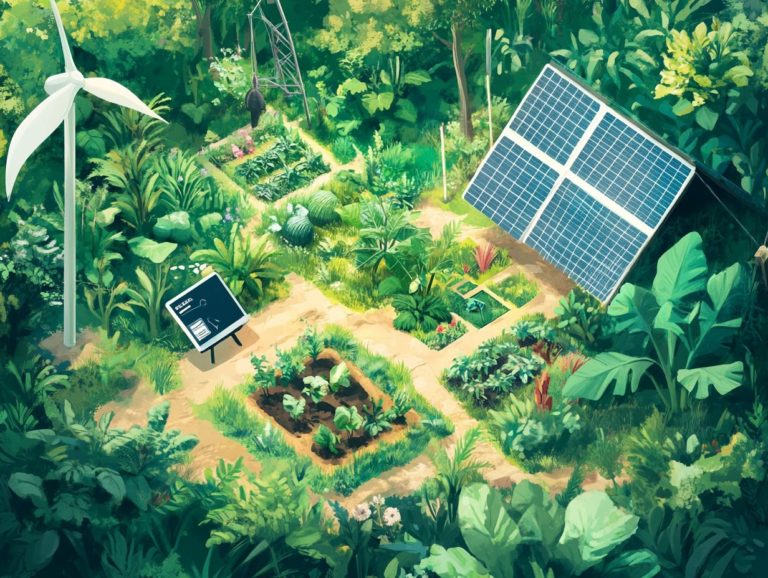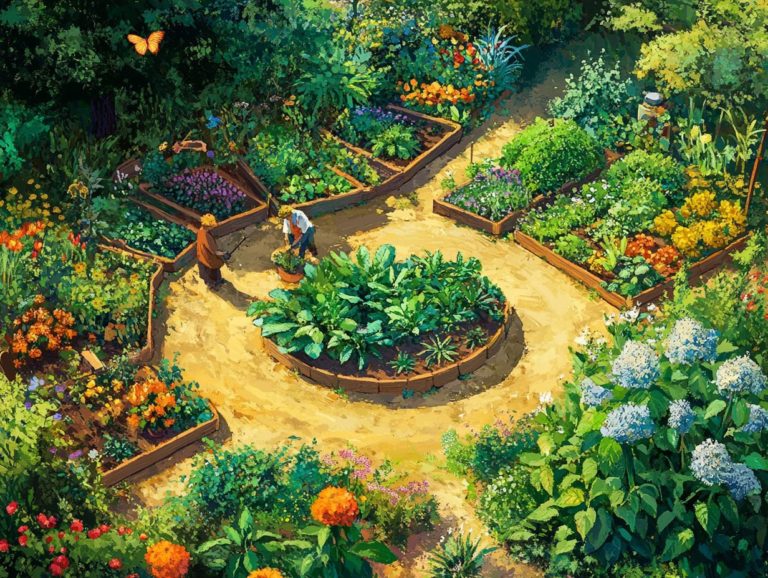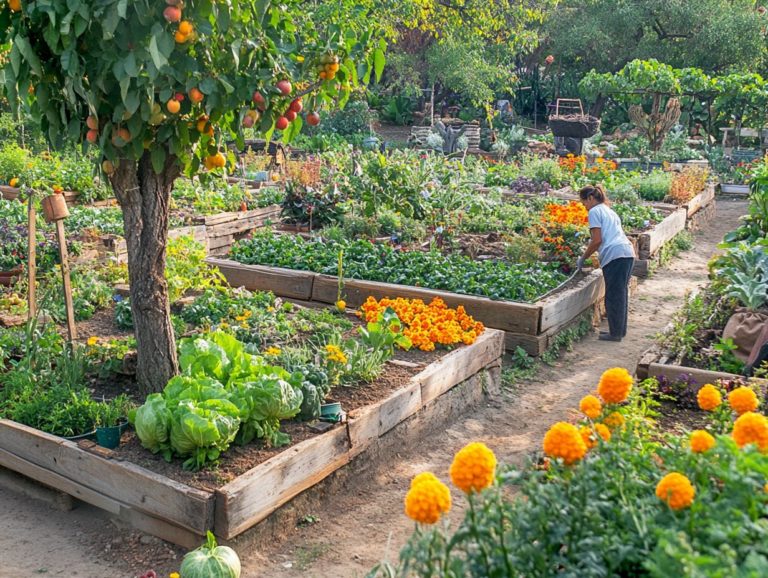7 Essential Principles of Permaculture Design
Permaculture design presents a sustainable approach to living in harmony with your environment, emphasizing ecological balance and resilience.
This article delves into the seven essential principles of permaculture. It guides you from the importance of observing and interacting with nature to the commitment to producing no waste.
You’ll discover how these principles can be applied across various environments and the benefits they bring to ecosystems. Additionally, you may encounter potential challenges during implementation.
Dive in! Explore how these timeless concepts can change your relationship with the earth for the better.
Contents
- Key Takeaways:
- 1. Observe and Interact
- 2. Catch and Store Energy
- 3. Obtain a Yield
- 4. Apply Self-Regulation and Accept Feedback
- 5. Use and Value Renewable Resources and Services
- 6. Produce No Waste
- 7. Design from Patterns to Details
- How Can Permaculture Principles Be Applied to Different Environments?
- Frequently Asked Questions
- What are the 7 Essential Principles of Permaculture Design?
- Why are the 7 Essential Principles of Permaculture Design important?
- How do the 7 Essential Principles of Permaculture Design work together?
- Can the 7 Essential Principles of Permaculture Design be applied to any design project?
- How can I learn more about the 7 Essential Principles of Permaculture Design?
- Are there any challenges in applying the 7 Essential Principles of Permaculture Design?
Key Takeaways:
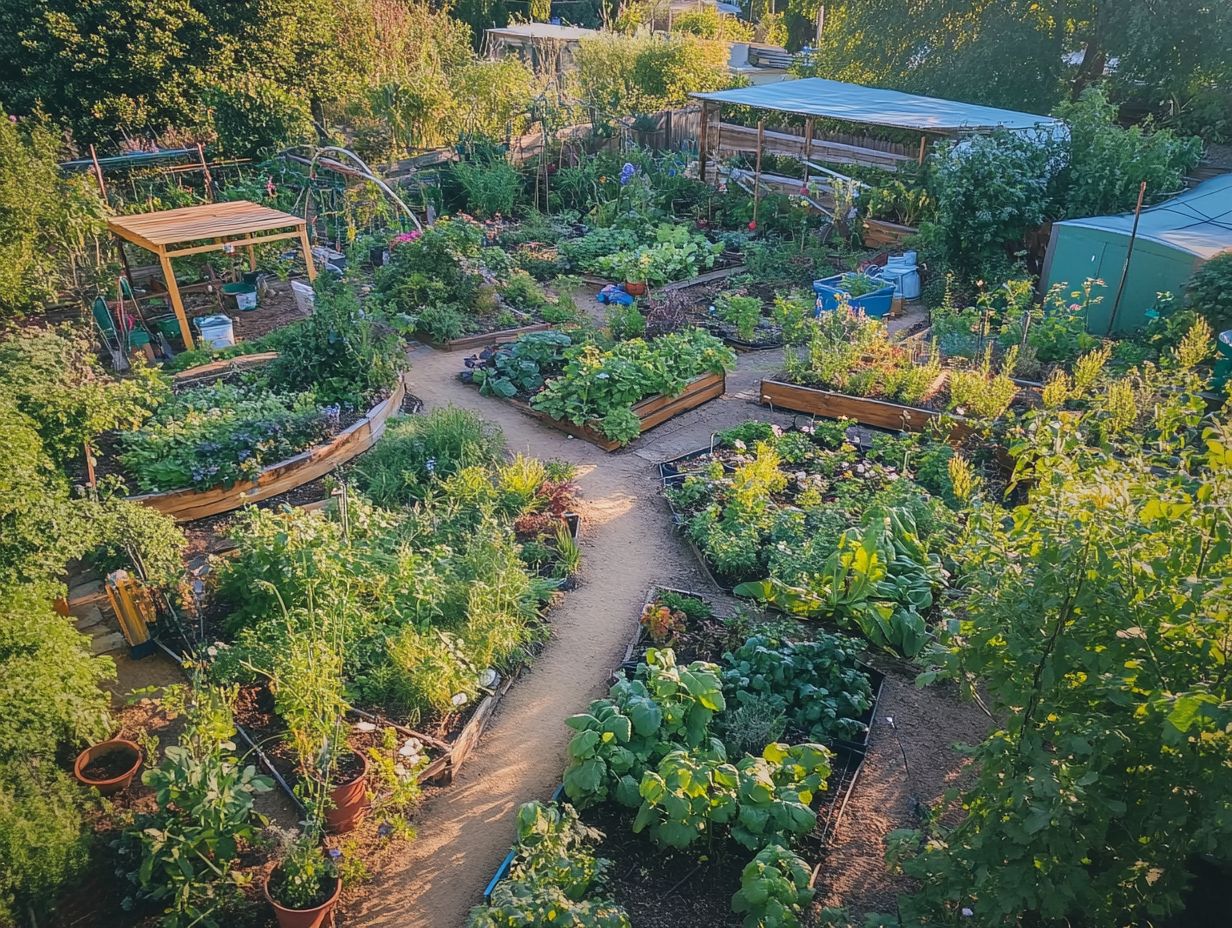
- Observe and interact with the environment to understand its patterns and potential.
- Efficiently capture and store energy from natural resources for sustainable use.
- Seek to obtain a yield from the land while also considering the long-term impact on the environment and community, particularly in relation to climate change.
1. Observe and Interact
In permaculture, the principle of ‘observe and interact’ is your gateway to thoughtful design. It encourages you to engage deeply with your surroundings, aligning with the ethics and principles of permaculture design. This engagement helps you appreciate the intricate relationships and patterns that exist in ecosystems.
This practice is essential. By observing carefully, you can identify natural patterns that inform effective management strategies.
Take community gardens, for example they often mirror local ecosystems and respond uniquely to their specific environments. Visionaries like Bill Mollison and David Holmgren highlight that by observing these dynamics, you enhance your decision-making, fostering resilience and adaptability.
When you tune into sun patterns, water flow, and soil types, you re not just creating a garden; you re designing a thriving ecosystem. This promotes community involvement and biodiversity. Engaging with these natural elements gives you the power to become a steward of the land, strengthening your connection to sustainable living practices.
2. Catch and Store Energy
The principle of ‘catch and store energy’ in permaculture highlights the importance of harnessing renewable resources to craft sustainable life solutions. This ultimately reduces your dependence on external energy sources.
By incorporating methods like rainwater harvesting, you can collect and use rainfall for irrigation. This helps lessen your reliance on municipal water systems. Likewise, solar power is a smart way to generate electricity from sunlight, resulting in lower utility bills and a reduced carbon footprint.
Embracing these practices fosters a holistic approach to sustainability. For example, using rainwater for gardening not only conserves precious resources, but also enhances soil health. These everyday actions benefit the environment and encourage your community to adopt a more eco-friendly lifestyle, showcasing the profound interconnectedness between personal choices and broader sustainability goals.
3. Obtain a Yield
In the realm of permaculture, the principle of “obtain a yield” underscores your ethical commitment to both the environment and your community. Every design decision you make should aim to yield tangible benefits, guided by the key elements of successful permaculture design, especially in urban farming settings.
This concept goes far beyond simply ramping up food production; it sets off a chain reaction of social and economic advantages that can truly revitalize neighborhoods. Take urban farms like Detroit s Neighbors Building Brightmoor, for example. They’ve sparked local economic revival by providing fresh produce that nourishes community members!
It also creates jobs and fosters local entrepreneurship. Then there s Brooklyn Grange in New York City, which has transformed rooftops into thriving green spaces. This initiative not only enhances food access but also engages the community!
It offers educational programs that empower residents. These successful models highlight how urban farming can bolster economic resilience while cultivating a strong sense of belonging and responsibility within the community, contributing to social change.
4. Apply Self-Regulation and Accept Feedback
Applying self-regulation and embracing feedback in permaculture is vital for you to adapt your designs and practices to ever-changing environmental conditions and community needs. This approach fosters a culture of continuous improvement and living in a way that protects our planet.
By actively engaging with community members, you can refine how you use resources, ensuring that your practices align seamlessly with local preferences and ecological realities. For example, a community garden in Portland implemented feedback loops, allowing residents to voice their concerns and suggestions.
This initiative led to a more efficient use of water and organic materials, boosting both crop yields and resource stewardship. Another example is a community garden in Detroit that employed self-regulatory practices to regularly assess soil health.
This not only enhanced growing conditions but also gave power to participants to take greater ownership of their environmental impact. These examples illustrate how mixing self-regulation and community feedback can drive sustainable practices that benefit both people and the planet, emphasizing ethical care for the environment.
5. Use and Value Renewable Resources and Services
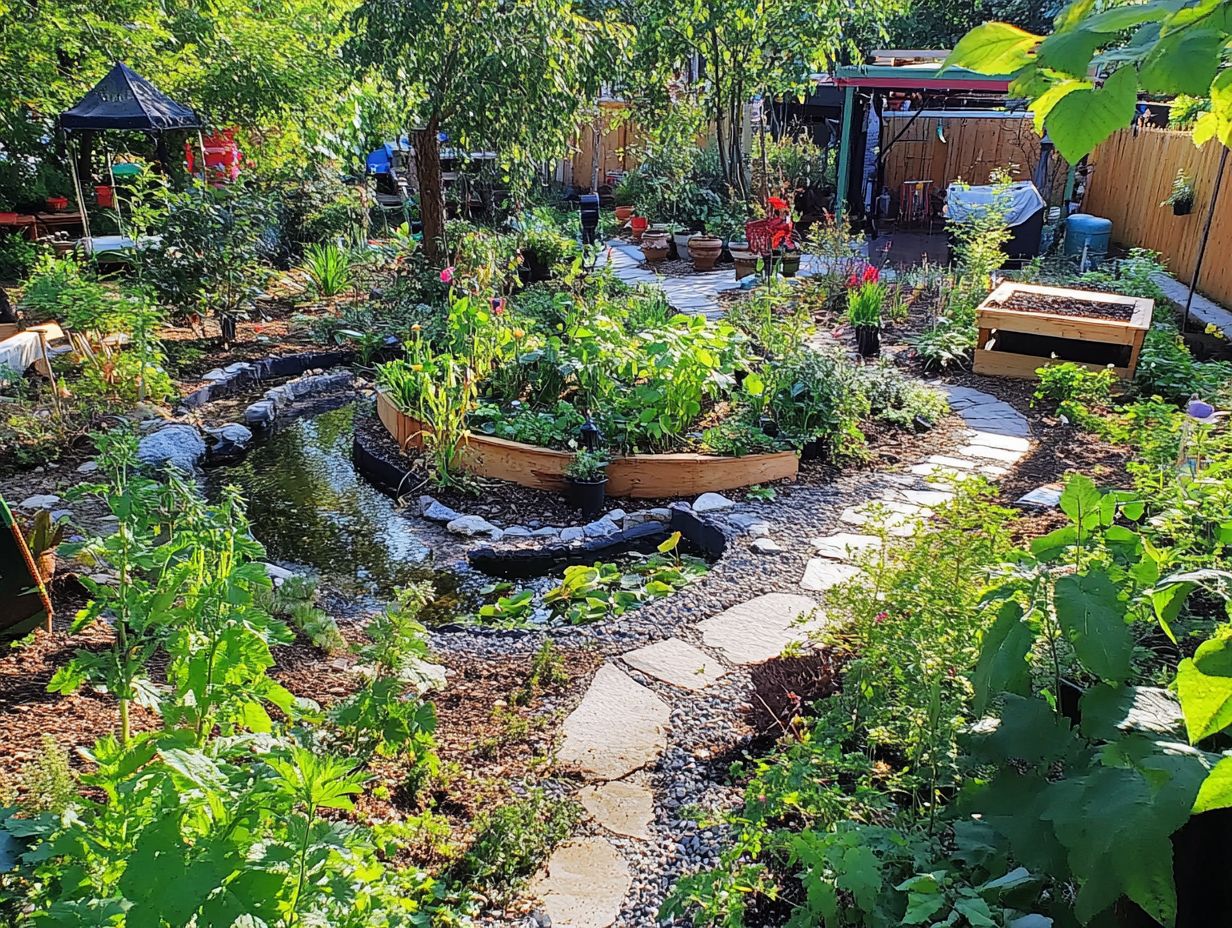
Emphasizing the use and value of renewable resources and services, permaculture encourages you to adopt practices that enhance biodiversity while promoting sustainable life through the utilization of natural systems, such as mycelium a type of fungus that helps improve soil health.
This holistic approach goes beyond mere plant cultivation; it incorporates essential elements like composting, transforming organic waste into nutrient-rich soil amendments that rejuvenate your garden.
Agroforestry plays a vital role as well, integrating trees and shrubs into your agricultural landscape, creating a habitat that nurtures a variety of species and ultimately enriches the ecosystem. Natural pest control methods further complement this framework!
They allow you to reduce reliance on harmful chemicals by harnessing the natural predator-prey relationships that thrive in diverse environments. Together, these interconnected practices form a resilient agricultural system essential for maintaining ecosystem health and supporting a sustainable future.
6. Produce No Waste
The principle of produce no waste in permaculture shows your commitment to caring for the environment. It encourages practices that cut down on waste and promote recycling resources.
This approach doesn t just shrink your environmental footprint; it deepens your connection with nature. Embracing strategies like composting helps return organic matter to the soil, enriching it and reducing what you send to landfills.
Implementing creative reuse of materials allows you to creatively repurpose items that might otherwise end up in the trash, transforming waste into valuable resources. Utilizing all parts of plants whether through cooking or crafting maximizes their potential and reduces reliance on external inputs.
Together, these practices enhance sustainability while cultivating community resilience, creating systems that are self-sufficient and environmentally conscious.
7. Design from Patterns to Details
In permaculture, designing from patterns to details empowers you to recognize and utilize natural patterns effectively. This approach enables you to build thriving agricultural systems and flourishing community gardens, incorporating essential elements for a permaculture design.
By understanding the interconnectedness of ecosystems, you can devise strategies mimicking nature s methods for achieving balance and sustainability. For example, observing how water flows across the landscape guides you in strategically placing swales or ponds, enhancing water retention and distribution.
Integrating plants that naturally support each other like the well-known ‘Three Sisters’ (corn, beans, and squash) demonstrates how these relationships boost growth while minimizing the need for synthetic inputs. Successful designs embracing this principle maximize yields and promote biodiversity, making both the environment and the community more resilient in the face of challenges.
How Can Permaculture Principles Be Applied to Different Environments?
Permaculture principles can easily adapt to various environments, whether you’re working with an urban farm or a rural landscape. By applying essential design principles, such as the 7 steps to effective permaculture design, you can foster community sufficiency and implement sustainable agriculture practices tailored to your unique context.
In urban settings, consider vertical gardens and rooftop farms that maximize limited space while optimizing your crop yield. Techniques like companion planting and aquaponics not only boost biodiversity but also enhance food security in densely populated areas.
In rural areas, integrating livestock with crop production can significantly improve soil health and minimize waste.
Look at case studies like the community gardens in Brooklyn or the regenerative farms in Vermont; they showcase how these practices flourish in their respective environments. By customizing permaculture techniques, you can help both urban and rural communities contribute to a resilient food system that nurtures people and the planet alike.
What Are the Key Components of Permaculture Design?
The key components of permaculture design include principles emphasizing understanding permaculture design principles that highlight patterns and details. These insights guide your sustainable life choices and foster ecological resilience.
These principles form the foundation for creating systems that coexist with nature while enhancing productivity. For instance, integrating diverse plant species cultivates a thriving ecosystem where each plant supports others through nutrient sharing and pest control. Understanding the principles of permaculture ethics can guide this symbiotic relationship, significantly reducing reliance on chemical inputs while promoting soil health.
Another vital aspect involves effective water management techniques, such as swales and rain gardens, which maximize water retention and minimize erosion. Act now to design sustainable landscapes that exemplify how permaculture principles contribute to a balanced, harmonious relationship with the environment.
How Can Permaculture Benefit the Environment?
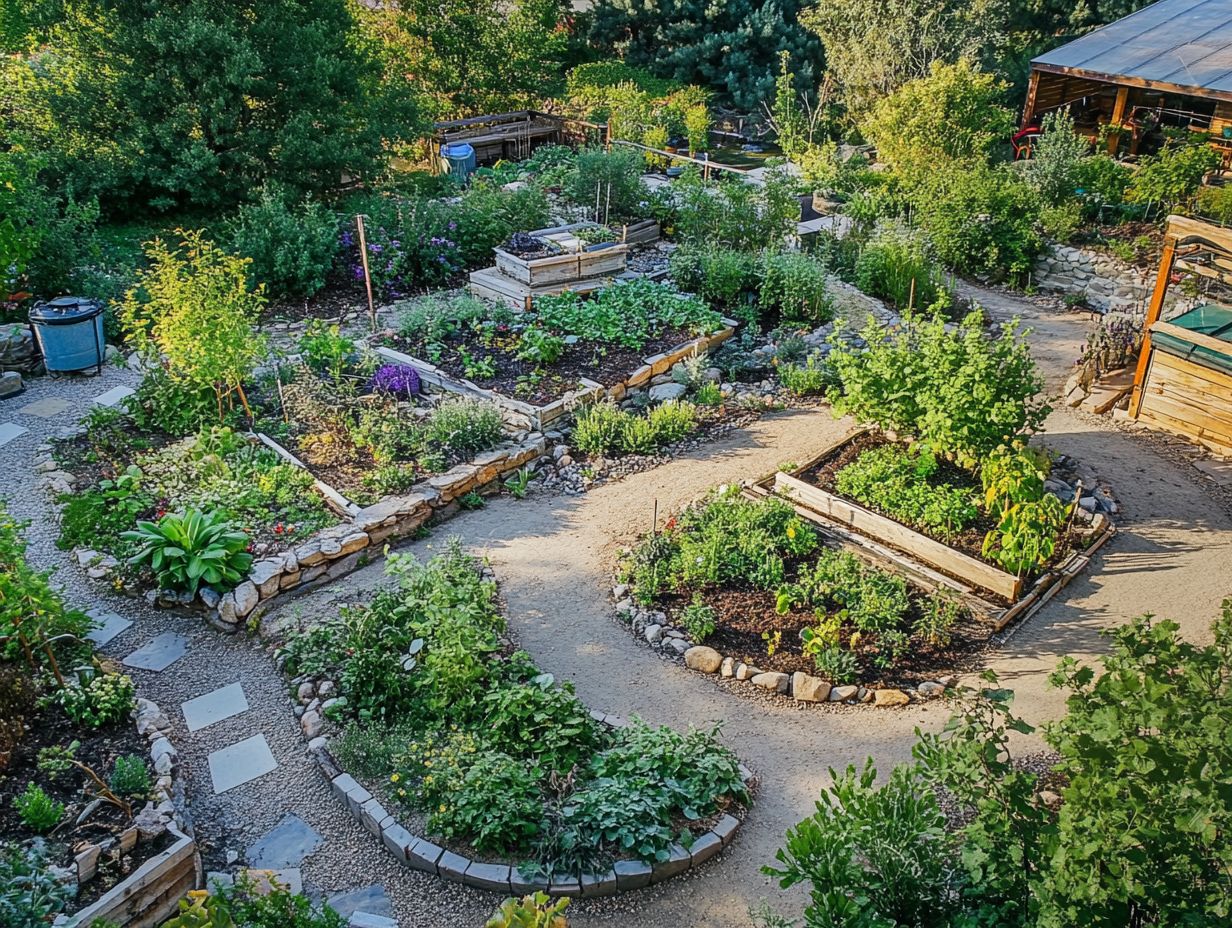
Permaculture provides substantial environmental advantages. It enhances biodiversity and bolsters resilience against climate change by cultivating ecosystems that harmonize with nature’s inherent patterns.
These practices are game-changers for sustainable agriculture. They significantly boost soil health through organic matter enrichment and reduced erosion. For example, an Australian study revealed that permaculture systems increased soil organic carbon levels by a remarkable 35%, translating into greater nutrient availability and healthier crops.
Water conservation techniques, such as swales and rainwater harvesting, effectively enhance water retention in arid regions. This means farmers can grow abundant produce even during dry spells.
Furthermore, these practices often restore natural habitats. A case study from Brazil illustrated how agroforestry systems revitalized local biodiversity and provided refuge to various species, beautifully showcasing the interconnectedness of healthy ecosystems and sustainable agriculture.
What Are the Challenges of Implementing Permaculture Design?
Implementing permaculture can be challenging, but it s also rewarding! Navigating agricultural systems, overcoming societal resistance, and garnering community support for sustainable initiatives are common hurdles.
While these challenges may seem daunting at first, with the right strategies, you can address them effectively. Securing funding is often a top concern; consider exploring grants, community crowdfunding, or establishing partnerships with local organizations for essential financial backing.
Education is equally critical. By hosting workshops and providing access to valuable resources, you can empower individuals and inspire groups to actively engage in permaculture practices.
Fostering community involvement through volunteer opportunities enhances local ownership and commitment. This ultimately fortifies support for sustainable initiatives within the community.
How Can Permaculture Be Incorporated into Everyday Life?
Incorporating permaculture into your everyday life is achievable through practical steps that promote low energy consumption and foster community sufficiency. This deepens your connection to the environment.
By starting small, you can create your own productive garden using native plants that require less water and maintenance it s a win-win for you and the planet.
Participating in local seed exchanges or community gardening initiatives not only strengthens your bonds with neighbors but also enhances food security in your area.
Hosting workshops on composting or methods for improving soil health allows you to educate others while cultivating a shared sense of responsibility for sustainable living. These small-scale solutions contribute to a larger movement toward ecological resilience, encouraging you to think globally while acting locally.
What Are Some Examples of Successful Permaculture Designs?
Successful permaculture designs flourish in various settings, from community gardens to urban farms, all of which emphasize biodiversity and sustainable practices.
These projects often serve as a beacon of inspiration for local communities, transforming barren, underutilized land into thriving ecosystems. For instance, a community garden that integrated native plants attracted a delightful array of pollinators while enhancing the overall health of the local habitat.
As residents came together in cooperative efforts, they not only bolstered their food security, but they also strengthened their social ties.
Such initiatives can significantly lower urban heat, improve soil fertility, and promote responsible water management, ultimately creating resilient environments that nurture both people and nature alike.
Frequently Asked Questions
What are the 7 Essential Principles of Permaculture Design?
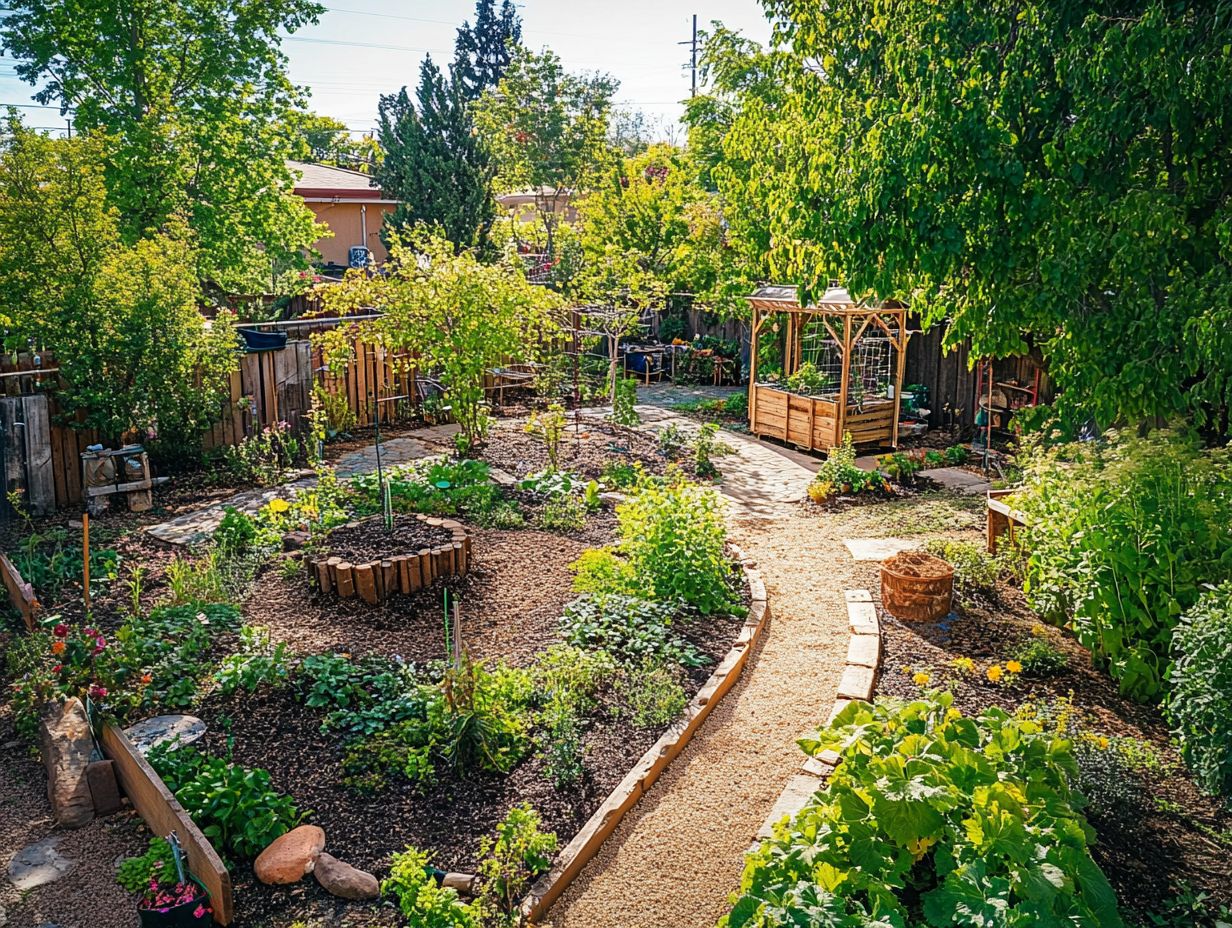
The 7 Essential Principles of Permaculture Design are guidelines created by Bill Mollison and David Holmgren. For a deeper understanding, the top 5 principles for effective permaculture design can further enhance sustainable and regenerative design practices by mimicking natural ecosystems.
Why are the 7 Essential Principles of Permaculture Design important?
The principles provide a way to build systems that are sustainable and can adapt. For those new to the topic, a beginner’s guide to permaculture design principles encourages creativity, efficiency, and long-term sustainability in design and living.
How do the 7 Essential Principles of Permaculture Design work together?
The principles are interconnected and interdependent. Each one builds on the others to create a harmonious and balanced whole.
Can the 7 Essential Principles of Permaculture Design be applied to any design project?
Absolutely! You can apply these principles to any design project, from a small garden to a large-scale farm.
How can I learn more about the 7 Essential Principles of Permaculture Design?
There are many resources available, including books, online courses, and workshops. Connect with other permaculture practitioners and observe their designs in action.
Are there any challenges in applying the 7 Essential Principles of Permaculture Design?
Yes, challenges can arise as these principles require a deep understanding of natural systems. It takes time and patience, but the rewards of a thriving, regenerative system are incredible! Dive in and start your journey now!

